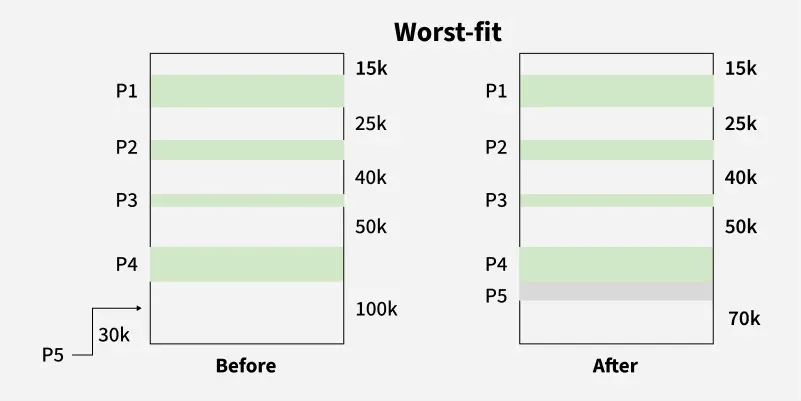Worst-Fit Allocation in Operating Systems
Last Updated :
15 Jul, 2025
For both fixed and dynamic memory allocation schemes, the operating system must keep a list of each memory location noting which are free and which are busy. Then as new jobs come into the system, the free partitions must be allocated.
These partitions can be allocated using four different methods, which are all contiguous memory allocation techniques:
- First-Fit Memory Allocation
- Best-Fit Memory Allocation
- Worst-Fit Memory Allocation
- Next-Fit Memory Allocation
Each of these techniques offers a unique approach to assigning memory blocks to processes.
Worst-Fit Memory Allocation
In Worst-Fit Memory Allocation allocation technique, the process traverses the whole memory and always search for the largest hole/partition, and then the process is placed in that hole/partition. It is a slow process because it has to traverse the entire memory to search the largest hole.
Algorithm for Worst Fit Memory Management Scheme
Step 1: Input the list of memory blocks along with their sizes.
Step 2: Input the list of processes with their sizes.
Step 3: For each process, check for the largest memory block (i.e., the block with the maximum size) that is large enough to accommodate the process.
Step 4: If such a block is found, allocate the process to that block and update the block size.
Step 5: If no suitable block is found, leave the process unallocated and move on to the next process.
Step 6: Repeat the above steps for all processes.
Step 7: Stop.
Refer Program for Worst Fit algorithm in Memory Management for implementation
 worst-fit
worst-fitAdvantages of Worst-Fit Allocation
- Reduces Chances of Small Fragments: By allocating the largest available block, worst fit leaves larger leftover fragments, which are more likely to be useful for future allocations.
- Simple to Implement: The logic is straightforward: find the largest block that can fit the process and allocate it.
- Efficient for Large Processes: It always looks for the biggest space, large processes may find better fits compared to other strategies like Best Fit or First Fit.
Disadvantages of Worst-Fit Allocation
- External Fragmentation: Worst-Fit Allocation can lead to significant external fragmentation. By allocating the largest available block, it often leaves behind many smaller, unusable fragments of memory.
- Inefficient Memory Usage: Allocating the largest block to a process, even if it's much larger than required, can lead to inefficient memory usage.
- Lower Allocation Time: Worst-Fit requires the operating system to search for the largest available block, which can be slower than methods like First-Fit or Next-Fit, especially if there are many free blocks.
Explore
OS Basics
Process Management
Memory Management
I/O Management
Important Links